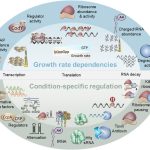In 1848, Hofmeister discovered chromosomes (chroma: color; soma: body) as darkly stained bodies in the pollen mother cells of Tradescantia and they show high affinity to basic dyes. The chromosomes are the genetic storage material of all the eukaryotes, and the number varies from 10 to 50 chromosomes: e.g. human have 23 pairs of or 46 chromosomes. Although it is more about DNA, proteins also form a part of chromosomes. Duplicated chromosomes are known as chromatids that are joined together by centromere.
Shape
The position of the centromere determines the shape of the chromosomes and of 4 types:
· Metacentric: V shaped and divides into equal arms.
· Submetacentric: L shaped and divides into unequal arms.
· Acrocentric: J shaped; centromere located near the end so that a short arm is seen.
· Telocentric: rod shaped; centromere located at one end.
Number and Size
The size of chromosomes varies from 0.5μ to 30μ in length 0.2μ to 3μ in diameter. Large chromosomes are seen in grasshoppers, animals, crickets and salamanders. Environmental conditions can influence the size: e.g. shorter chromosomes in cells dividing at low temperature. The number of chromosome is in diploid condition (2n), while haploid (n) only in gametes.
Structure
Chromosomes are coiled thread-like structures observed in the matrix and consists of
• Chromatids—2 in number held by centromere; spirally coiled known as chromonema composed of 2, 4, or more fibers; paranemic or plectonemic coils;
• Centromere—joining point or primary constriction of chromosomes; also known as kinetochore or kinetomere;
• Secondary constrictions—One or more constrictions other than centromere;
• Nucleolar organizers—additional constrictions that are necessary to form nucleolus;
• Telomeres—end of the chromosome;
• Satellites



